Analysis of Drought Intensity and Trends Using the Modified SPEI in South Korea from 1981 to 2010
Abstract
:1. Introduction
2. Materials and Methods
2.1. Modified SPEI
2.2. Analysis of Drought Intensity through Runs Theory
2.3. Analysis of Drought Trends through Mann–Kendall Test
2.4. Site Description
3. Results and Discussion
3.1. Calculation of SPEI from 1981 to 2010
3.2. Analysis of Intensity and Frequency of Drought
3.3. Analysis of Variability and Trends of Drought
4. Conclusions
Acknowledgments
Author Contributions
Conflicts of Interest
References
- Wilhite, D.A. Drought as a natural hazard: Concepts and definitions. In Drought: A Global Assessment; Wilhite, D.A., Ed.; Routledge: London, UK, 2000; pp. 3–18. [Google Scholar]
- Vrochidou, A.E.; Tsanis, I.K.; Grillakis, M.G.; Koutroulis, A.G. The impact of climate change on hydrometeorological droughts at a basin scale. J. Hydrol. 2013, 476, 290–301. [Google Scholar] [CrossRef]
- Koutroulis, A.G.; Vrochidou, A.-E.K.; Tsanis, I.K. Spatiotemporal characteristics of meteorological drought for the island of Crete. J. Hydrometeorol. 2011, 12, 206–226. [Google Scholar] [CrossRef]
- Rossi, G. Drought mitigation measures: A comprehensive framework. In Drought and Drought Mitigation in Europe; Voght, J., Somma, F., Eds.; Kluwer Academic Publishers: Dordrecht, The Netherlands, 2000; pp. 233–246. [Google Scholar]
- Mishra, A.K.; Singh, V.P. A review of drought concepts. J. Hydrol. 2010, 391, 202–216. [Google Scholar] [CrossRef]
- Lei, T.; Pang, Z.; Wang, X.; Li, L.; Fu, J.; Kan, G.; Shao, C. Drought and carbon cycling of grassland ecosystems under global change: A review. Water 2016, 8, 460. [Google Scholar] [CrossRef]
- Stocker, T.F.; Dahe, Q.; Plattner, G.-K. Climate Change 2013: The Physical Science Basis. Working Group I Contribution to the Fifth Assessment Report of the Intergovernmental Panel on Climate Change; Summary for Policymakers (IPCC, 2013); IPCC: Bern, Switzerland, 2013; pp. 1–33. [Google Scholar]
- Vogel, A.; Scherer-Lorenzen, M.; Weigelt, A. Grassland resistance and resilience after drought depends on management intensity and species richness. PLoS ONE 2012, 7, e36992. [Google Scholar] [CrossRef] [PubMed]
- Heim, R.R. A review of twentieth-century drought indices used in the United States. Bull. Am. Meteorol. Soc. 2002, 83, 1149–1165. [Google Scholar] [CrossRef]
- Svoboda, M.D.; LeComte, D.; Hayes, M.; Heim, R.; Gleason, K.; Angel, J.; Miskus, D. The drought monitor. Bull. Am. Meteorol. Soc. 2002, 83, 1181–1190. [Google Scholar] [CrossRef]
- Wilhite, D.A.; Glantz, M.H. Understanding the drought phenomenon: The role of definitions. Water Int. 1985, 10, 111–120. [Google Scholar] [CrossRef]
- World Meteorological Organization. Drought and Agriculture. WMO Tech. Note 138, Report of the CAgM Working Group on the Assessment of Drought; World Meteorological Organization: Geneva, Switzerland, 1975; p. 127. [Google Scholar]
- Dai, A. Drought under global warming: A review. Wiley Interdiscip. Rev. Clim. Chang. 2011, 2, 45–65. [Google Scholar] [CrossRef]
- Dubrovsky, M.; Svoboda, M.D.; Trnka, M.; Hayes, M.J.; Wilhite, D.A.; Zalud, Z.; Hlavinka, P. Application of relative drought indices in assessing climate change impacts on drought conditions in Czechia. Theor. Appl. Climatol. 2009, 96, 117–155. [Google Scholar] [CrossRef]
- Loukas, A.; Vasiliades, L.; Tzabiras, J. Climate change effects on drought severity. Adv. Geosci. 2008, 17, 23–29. [Google Scholar] [CrossRef]
- Mavromatis, T. Drought index evaluation for assessing future wheat production in Greece. Int. J. Climatol. 2007, 27, 911–924. [Google Scholar] [CrossRef]
- Vicente-Serrano, S.M.; Beguería, S.; López-Moreno, J.I. A multiscalar drought index sensitive to global warming: The standardized precipitation evapotranspiration index. J. Clim. 2010, 23, 1696–1718. [Google Scholar] [CrossRef]
- Hayes, M.J.; Svoboda, M.D.; Wilhite, D.A.; Vanyarkho, O.V. Monitoring the 1996 drought using the standardized precipitation index. Bull. Am. Meteorol. Soc. 1999, 80, 429–438. [Google Scholar] [CrossRef]
- Nam, W.H.; Hayes, M.J.; Wilhite, D.A.; Tadesse, T.; Svoboda, M.D.; Knutson, C.L. Drought management and policy based on risk assessment in the context of climate change. Mag. Korean Soc. Agric. Eng. 2014, 56, 2–15. (In Korean) [Google Scholar]
- Wilhite, D.A.; Svoboda, M.D.; Hayes, M.J. Understanding the complex impacts of drought: A key to enhancing drought mitigation and preparedness. Water Resour. Manag. 2007, 21, 763–774. [Google Scholar] [CrossRef]
- Kwak, J.W.; Lee, S.D.; Kim, Y.S.; Kim, H.S. Return period estimation of droughts using drought variables from standardized precipitation index. J. Korean Water Resour. Assoc. 2013, 46, 795–805. (In Korean) [Google Scholar] [CrossRef]
- Nam, W.H.; Yoo, S.H.; Jang, M.W.; Choi, J.Y. Application of meteorological drought indices for North Korea. J. Korean Soc. Agric. Eng. 2008, 50, 3–15. (In Korean) [Google Scholar] [CrossRef]
- So, J.M.; Sohn, K.H.; Bae, D.H. Estimation and assessment of bivariate joint drought index based copula functions. J. Korean Water Resour. Assoc. 2014, 47, 171–182. (In Korean) [Google Scholar] [CrossRef]
- Yoo, J.Y.; Choi, M.H.; Kim, T.W. Spatial analysis of drought characteristics in Korea using cluster analysis. J. Korean Water Resour. Assoc. 2010, 43, 15–24. (In Korean) [Google Scholar] [CrossRef]
- Yoo, J.Y.; Song, H.Y.; Kim, T.W.; Ahn, J.H. Evaluation of short-term drought using daily standardized precipitation index and ROC analysis. J. Korean Soc. Civ. Eng. 2013, 33, 1851–1860. (In Korean) [Google Scholar] [CrossRef]
- Jeung, S.J.; Sung, J.H.; Kim, B.S. Change projection of extreme indices using RCP climate change scenario. J. Korean Water Resour. Assoc. 2013, 46, 1089–1101. (In Korean) [Google Scholar] [CrossRef]
- Rim, C.S.; Kim, S.Y. Climate aridity/humidity characteristics in Seoul according to changes in temperature and precipitation based on RCP 4.5 and 8.5. J. Korean Water Resour. Assoc. 2014, 47, 421–434. (In Korean) [Google Scholar] [CrossRef]
- Yoon, S.K.; Cho, J.P.; Moon, Y.I. Non-parametric low-flow frequency analysis using RCPs scenario data: A case study of the Gwangdong storage reservoir, Korea. J. Korean Soc. Civ. Eng. 2014, 34, 1125–1138. (In Korean) [Google Scholar] [CrossRef]
- Thornthwaite, C.W. An approach toward a rational classification of climate. Geogr. Rev. 1948, 38, 55–94. [Google Scholar] [CrossRef]
- Kim, B.S.; Sung, J.H.; Kang, H.S.; Cho, C.H. Assessment of drought severity over South Korea using standardized precipitation evapotranspiration index (SPEI). J. Korean Water Resour. Assoc. 2012, 45, 887–900. (In Korean) [Google Scholar] [CrossRef]
- Jensen, M.E.; Burman, R.D.; Allen, R.G. Evapotranspiration and Irrigation Water Requirements; American Society of Civil Engineers (ASCE): Reston, VA, USA, 1990. [Google Scholar]
- Van der Schrier, G.; Jones, P.D.; Briffa, K.R. The sensitivity of the PDSI to the Thornthwaite and Penman-Monteith parameterizations for potential evapotranspiration. J. Geophys. Res. Atmos. 2011, 1984–2012. [Google Scholar] [CrossRef]
- Allen, R.G.; Pereira, L.S.; Raes, D.; Smith, M. Crop Evapotranspiration-Guidelines for Computing Crop Water Requirements-FAO Irrigation and Drainage Paper 56; FAO: Rome, Italy, 1998; Volume 300, p. D05109. [Google Scholar]
- Yevjevich, V. An Objective Approach to Definitions and Investigations of Continental Hydrologic Drought; Hydrology Paper No. 23; Colorado State University: Fort Collins, CO, USA, 1967. [Google Scholar]
- González, J.; Valdés, J.B. New drought frequency index: Definition and comparative performance analysis. Water Resour. Res. 2006, 42. [Google Scholar] [CrossRef]
- Lee, S.H.; Yoo, S.H.; Choi, J.Y.; Bae, S. Assessment of the impact of climate change on drought characteristics in the Hwanghae plain, North Korea using time series SPI and SPEI: 1981–2100. Water 2017, 9, 579. [Google Scholar] [CrossRef]
- Mann, H.B. Nonparametric tests against trend. Econometrica 1945, 13, 245–259. [Google Scholar] [CrossRef]
- Wang, W.; Van Gelder, P.H.A.J.M.; Vrijling, J.K. Trend and stationarity analysis for streamflow processes of rivers in Western Europe in the 20th century. In Proceedings of the IWA International Conference on Water Economics, Statistics, and Finance, Rethymno, Greece, 8–10 July 2005; p. 810. [Google Scholar]
- Kendall, M.G. Rank Correlation Methods; Griffin: London, UK, 1975. [Google Scholar]
- Kim, B.S.; Sung, J.H.; Lee, B.H.; Kim, D.J. Evaluation on the impact of extreme droughts in South Korea using the SPEI and RCP8.5 climate change scenario. J. Korean Soc. Hazard Mitig. 2013, 13, 97–109. (In Korean) [Google Scholar] [CrossRef]
- Korea Meteorological Administration (KMA). Understanding of Climate Change and Application of Climate Change Scenarios; National Institute of Meteorological Research: Seoul, Korea, 2010. (In Korean)
- Korea rural community corporation (KRC). Mitigation History of Drought; KRC: Naju, Korea, 2001. [Google Scholar]
- Lee, J.H.; Seo, J.W.; Kim, C.J. Analysis on trends, periodicities and frequencies of Korean drought using drought indices. J. Korea Water Resour. Assoc. 2012, 45, 75–89. [Google Scholar] [CrossRef]
- Ministry of Construction and Transportation (MCT). Drought Impact Survey Report; MCT: Sejong, Korea, 2002. [Google Scholar]
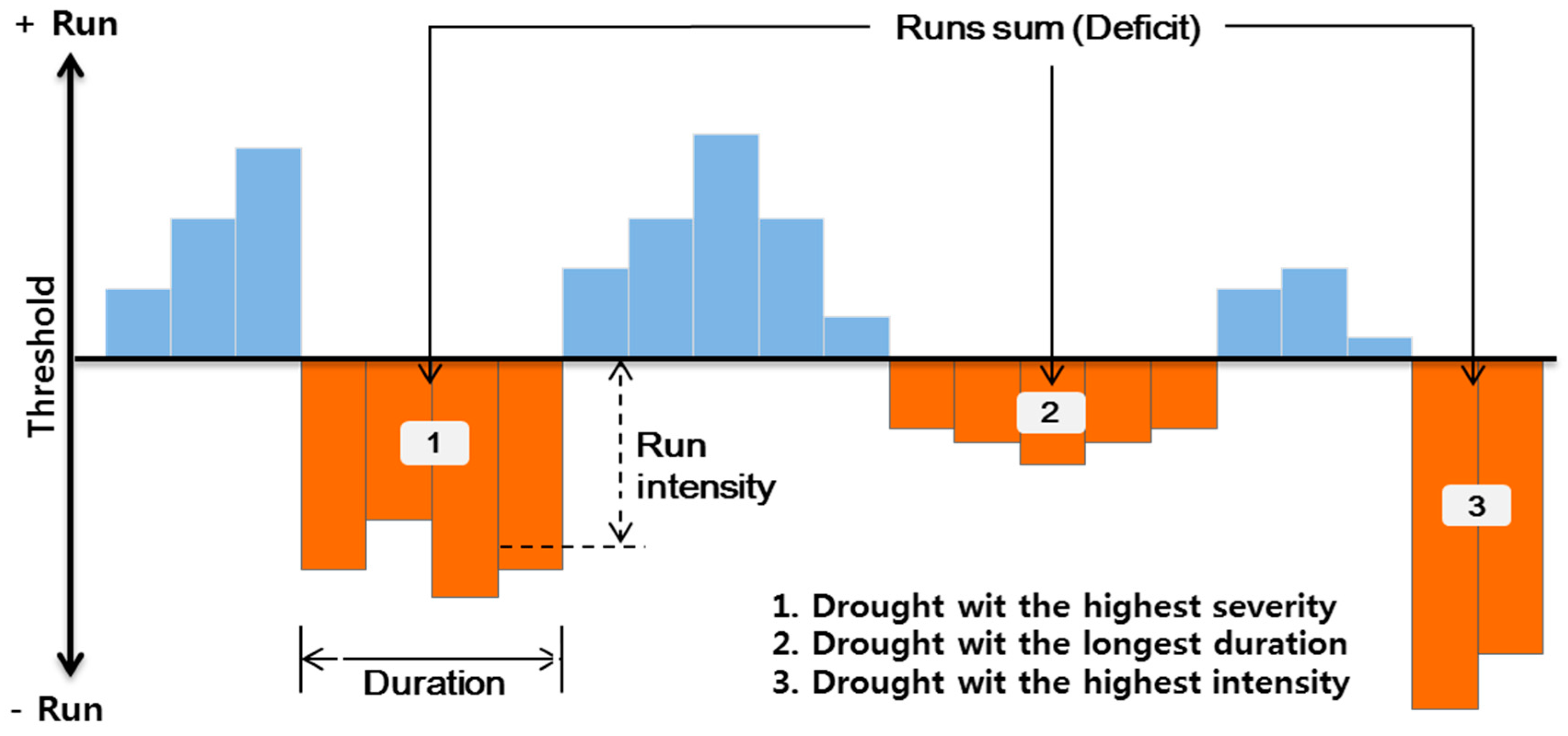
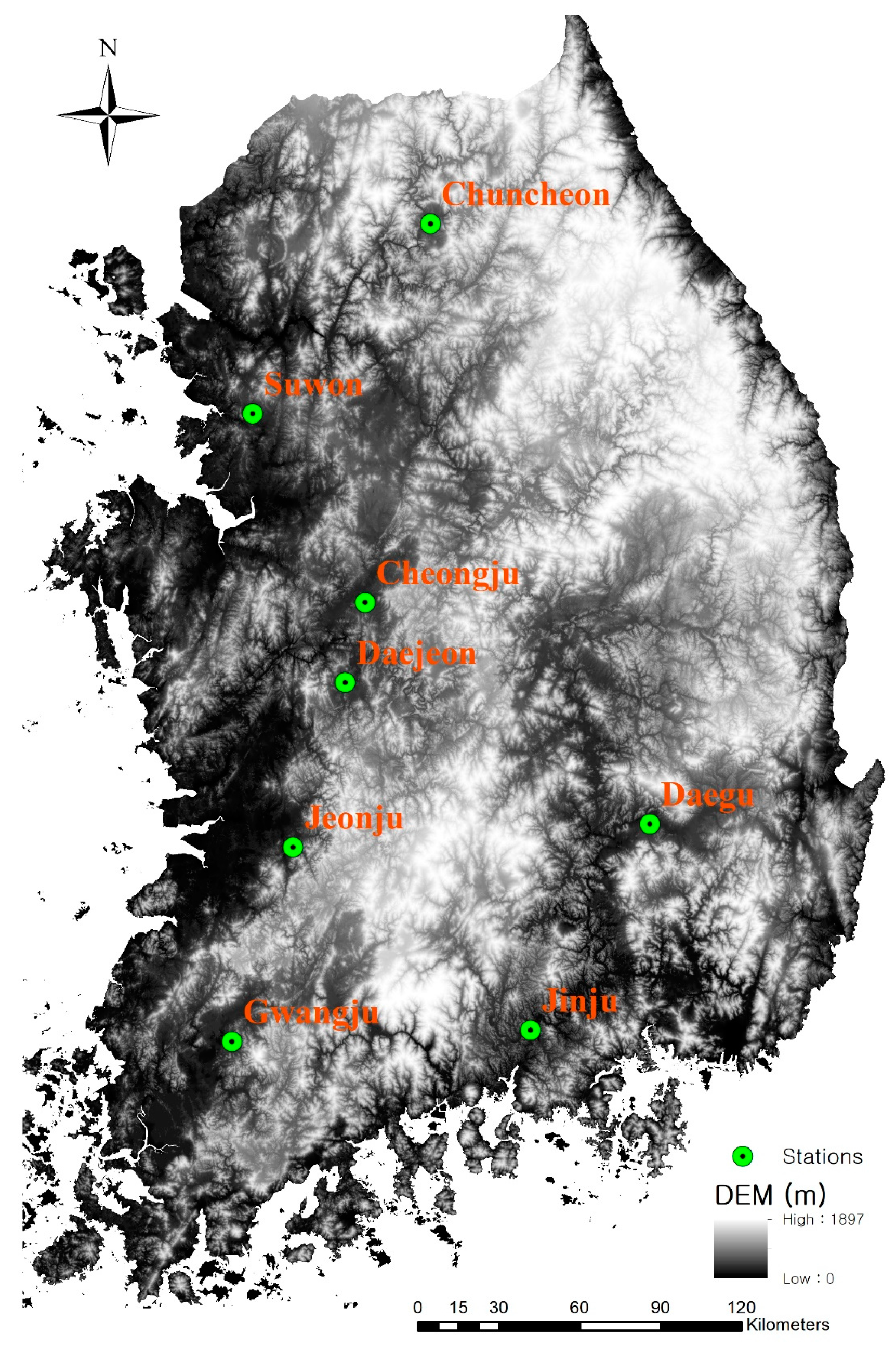
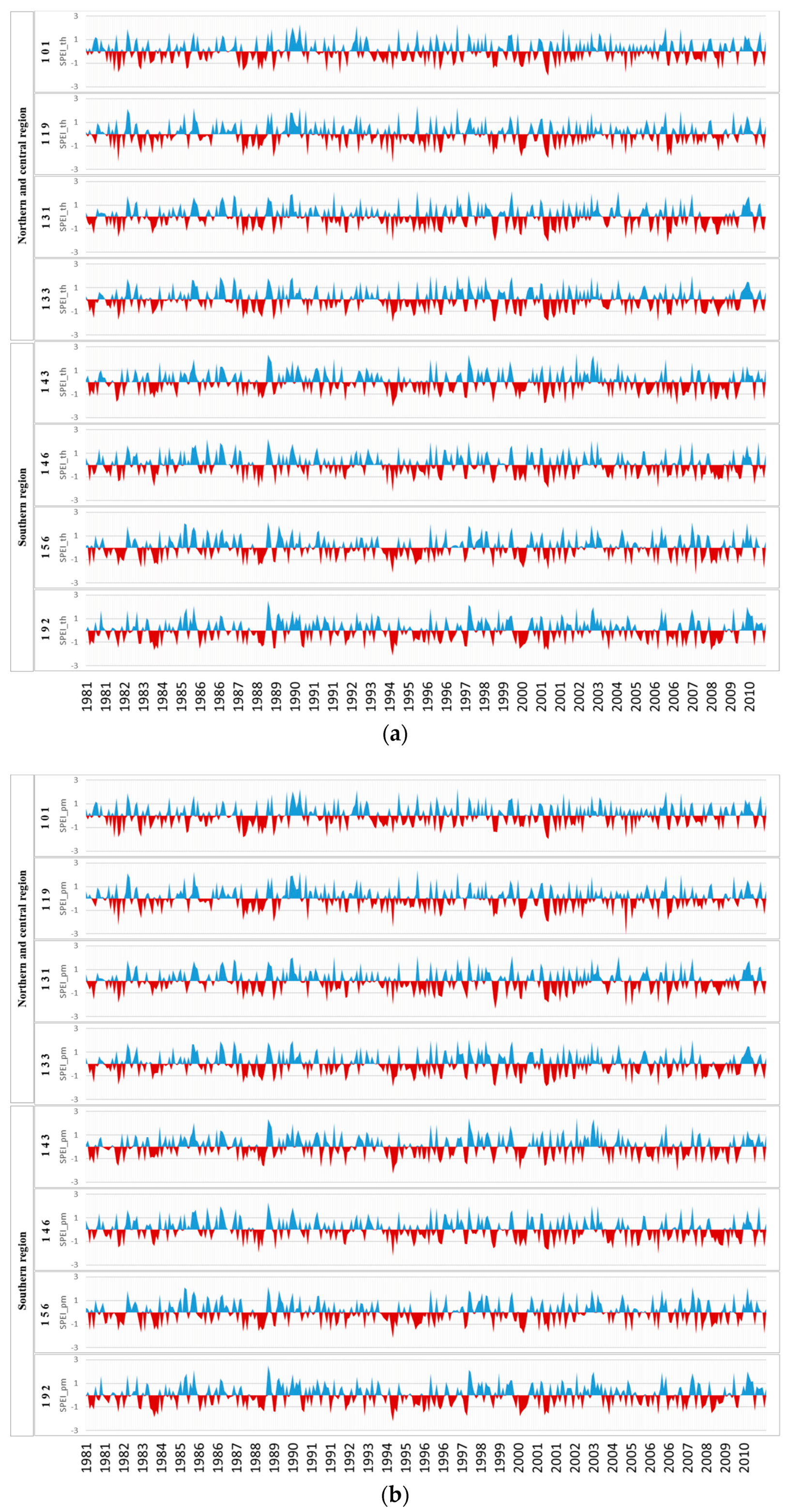
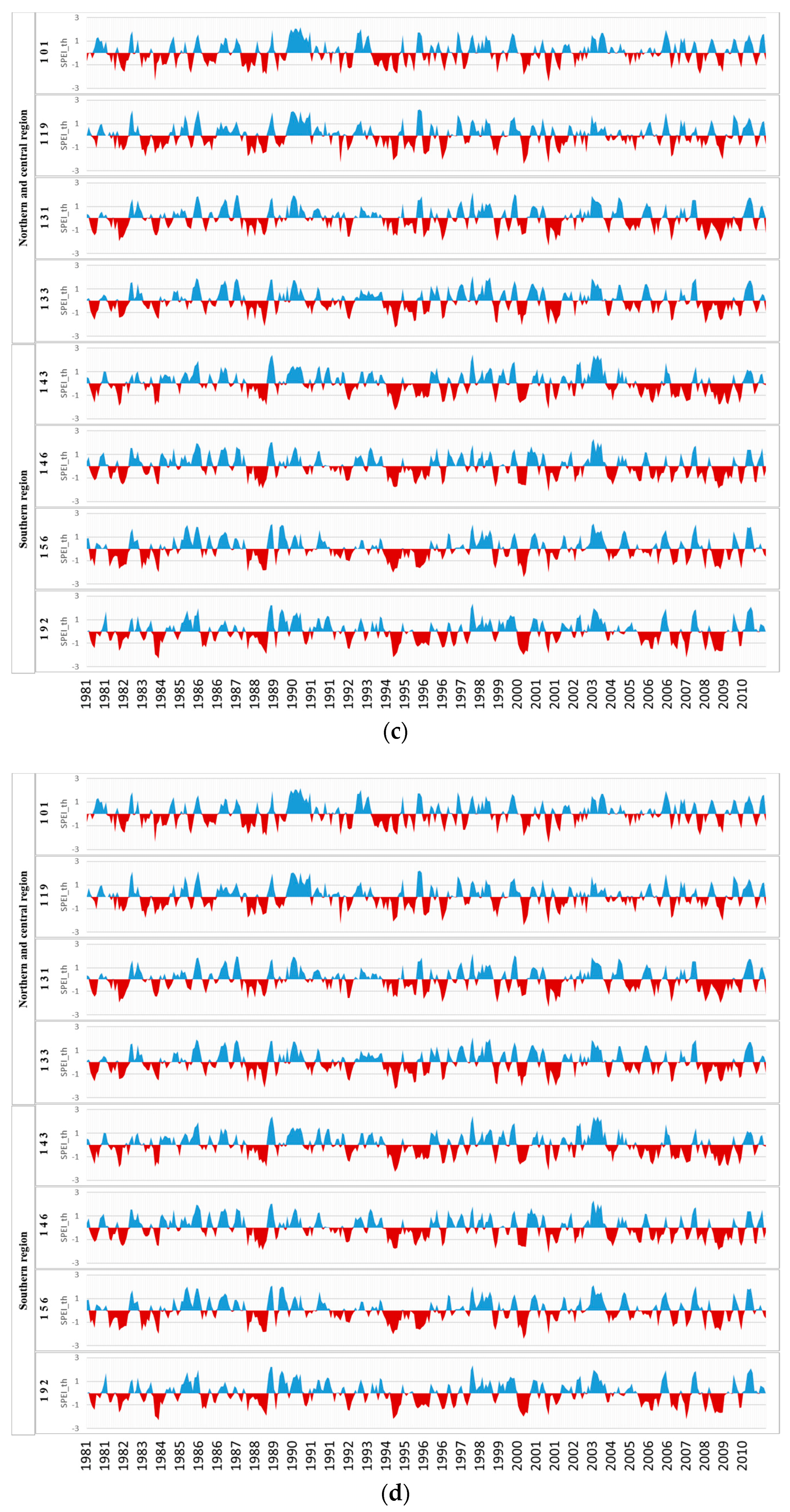

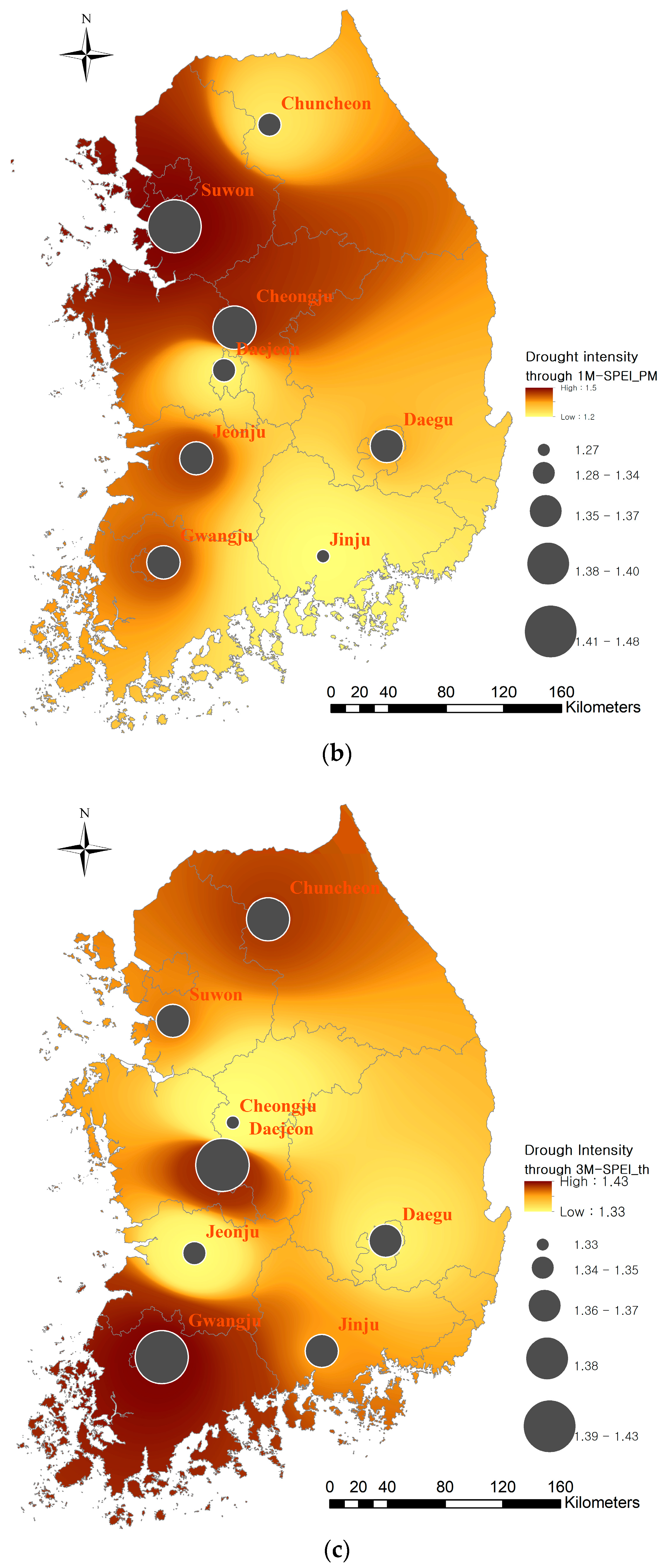
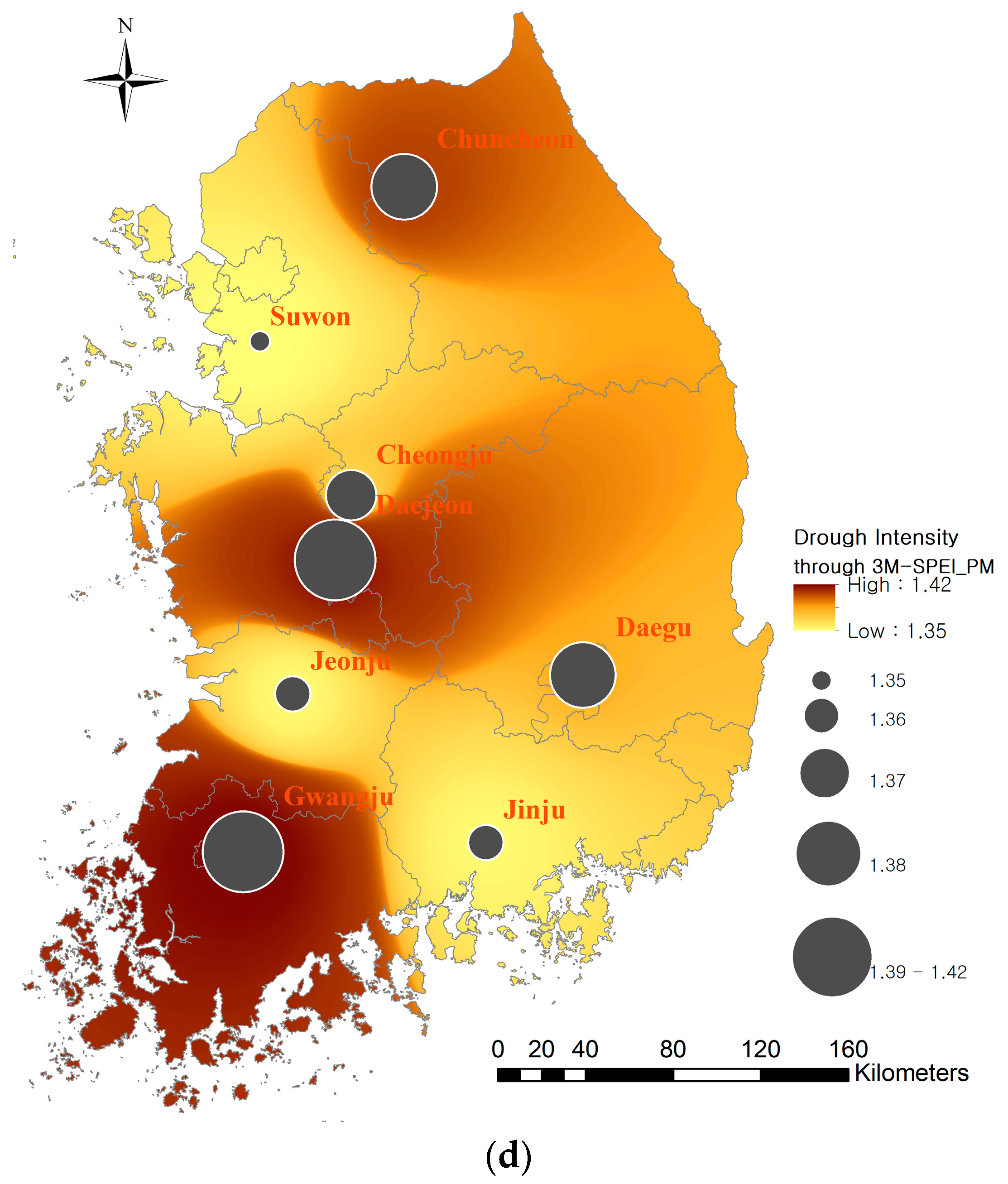

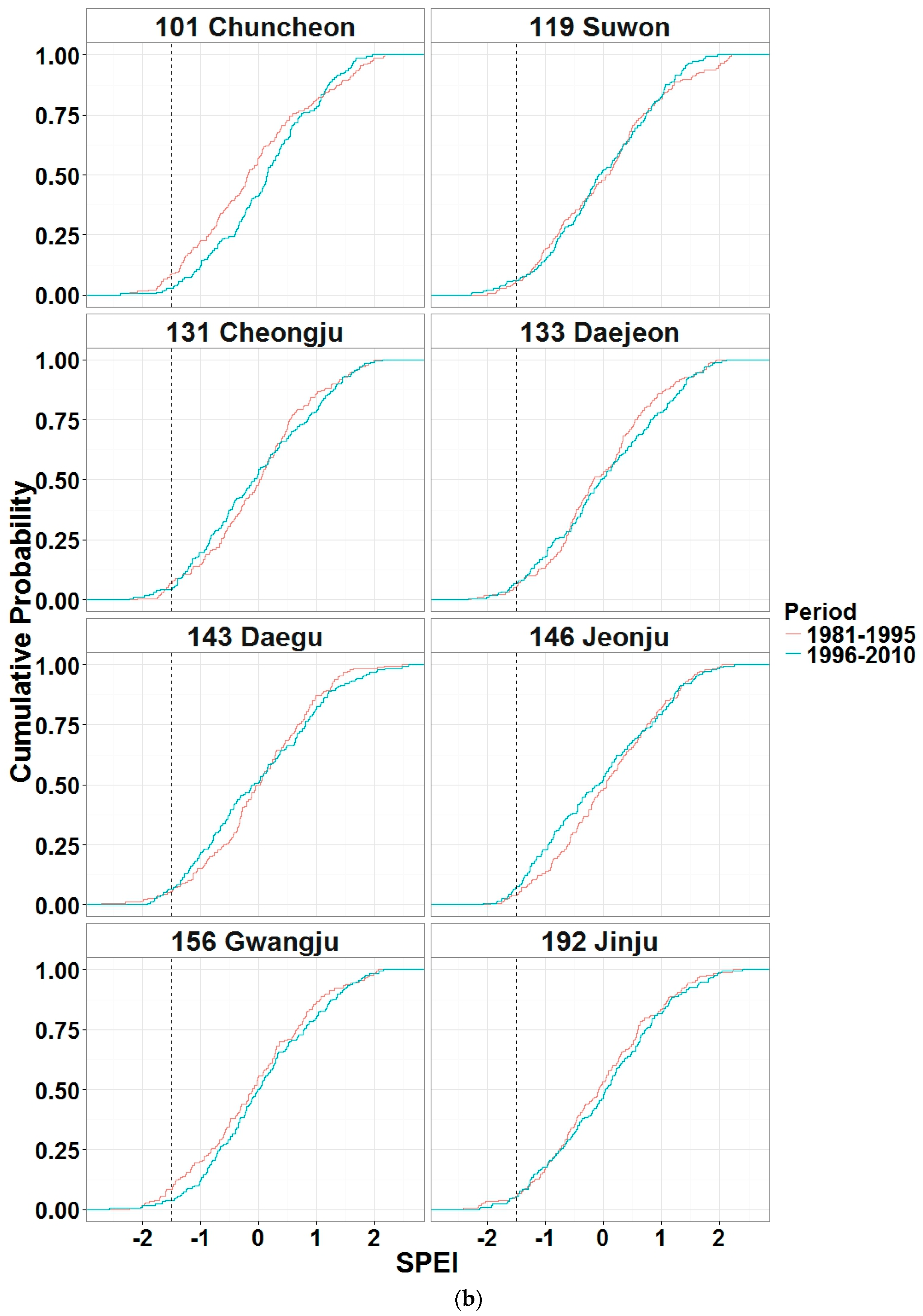
| SPEI Value | Class |
|---|---|
| More than 2.00 | Extremely wet (humid) |
| 1.50–1.99 | Severely wet |
| 1.00–1.49 | Moderately wet |
| 0.50–0.99 | Slightly wet |
| −0.49–0.49 | Near normal |
| −0.99–−0.50 | Mild dry |
| −1.49–−1.00 | Moderately dry |
| −1.99–−1.50 | Severely dry |
| Less than −2.00 | Extremely dry (drought) |
| Stations (No.) | Annual Mean Temperature (°C) | Annual Rainfall (mm) |
|---|---|---|
| Chuncheon (101) | 11.2 | 1357.4 |
| Suwon (119) | 12.2 | 1333.3 |
| Cheongju (131) | 12.6 | 1249.8 |
| Daejeon (133) | 12.8 | 1373.9 |
| Daegu (143) | 14.2 | 1076.1 |
| Jeonju (146) | 13.4 | 1317.7 |
| Gwangju (156) | 13.9 | 1385.7 |
| Jinju (192) | 13.2 | 1523.0 |
| Chuncheon (101) Month | Goodness of Fit of D Series by Kolmogorov–Smirnov | |||
|---|---|---|---|---|
| Thornthwaite | FAO Penman–Monteith | |||
| Static Value | Rank * | Static Value | Rank * | |
| 1 | 0.0871 | 1 | 0.11108 | 11 |
| 2 | 0.1423 | 21 | 0.14446 | 12 |
| 3 | 0.0890 | 14 | 0.0873 | 5 |
| 4 | 0.1020 | 9 | 0.06298 | 2 |
| 5 | 0.1075 | 21 | 0.11559 | 21 |
| 6 | 0.0792 | 3 | 0.09832 | 12 |
| 7 | 0.1210 | 12 | 0.11977 | 14 |
| 8 | 0.0695 | 5 | 0.08334 | 10 |
| 9 | 0.0869 | 8 | 0.09027 | 9 |
| 10 | 0.0917 | 11 | 0.13055 | 3 |
| 11 | 0.1011 | 15 | 0.13402 | 10 |
| 12 | 0.0961 | 7 | 0.08922 | 14 |
| SPEIs | Regions | Stations (No.) | Z Score | |||
|---|---|---|---|---|---|---|
| DJF | MAM | JJA | SON | |||
| SPEI_th | Northern and Central | Chuncheon (101) | 0.17 | 0.00 | 1.59 | −1.03 |
| Suwon (119) | −0.25 | −0.36 | 1.59 | −1.30 | ||
| Cheongju (131) | −0.36 | 0.03 | 0.68 | −2.37 * | ||
| Daejeon (133) | 0.22 | 0.13 | 0.51 | −2.46 * | ||
| Southern | Daegu (143) | 0.06 | −0.36 | −0.38 | −2.30 * | |
| Jeonju (146) | −0.16 | −1.25 | 0.72 | −3.65 * | ||
| Gwangju (156) | 1.25 | 0.37 | 1.35 | −2.39 * | ||
| Jinju (192) | 0.17 | 0.79 | 0.17 | −1.38 | ||
| SPEI_pm | Northern and central | Chuncheon (101) | 0.11 | 0.63 | 1.78 | −0.38 |
| Suwon (119) | −1.32 | −0.17 | 1.75 | −1.11 | ||
| Cheongju (131) | −0.96 | 0.13 | 0.91 | −1.68 | ||
| Daejeon (133) | −0.33 | −0.24 | 0.69 | −2.25 * | ||
| Southern | Daegu (143) | −0.23 | −0.21 | −0.03 | −1.35 | |
| Jeonju (146) | −0.80 | −1.61 | 0.88 | −3.55 * | ||
| Gwangju (156) | 0.99 | 0.37 | 1.52 | −1.88 | ||
| Jinju (192) | 1.14 | 0.75 | 0.19 | −0.99 | ||
| SPEIs | Regions | Stations (No.) | Z Score | |||
|---|---|---|---|---|---|---|
| DJF | MAM | JJA | SON | |||
| SPEI_th | Northern and central | Chuncheon (101) | −0.48 | 1.29 | 2.16 * | 0.75 |
| Suwon (119) | −2.36 * | 0.06 | 3.01 * | 0.48 | ||
| Cheongju (131) | −2.83 * | −0.27 | 1.27 | 0.14 | ||
| Daejeon (133) | −2.15 * | 0.41 | 1.32 | 0.10 | ||
| Southern | Daegu (143) | −1.90 | −2.02 * | 0.23 | −0.87 | |
| Jeonju (146) | −3.28 * | −1.56 | 0.64 | −0.63 | ||
| Gwangju (156) | −1.38 | 0.10 | 1.07 | 0.50 | ||
| Jinju (192) | −0.42 | 0.51 | 0.95 | −0.79 | ||
| SPEI_pm | Northern and central | Chuncheon (101) | −0.52 | 1.47 | 2.67 * | 1.15 |
| Suwon (119) | −3.16 * | −0.34 | 3.26 * | 0.72 | ||
| Cheongju (131) | −3.26 * | −0.59 | 1.84 | 0.49 | ||
| Daejeon (133) | −2.65 * | −0.33 | 1.39 | 0.25 | ||
| Southern | Daegu (143) | −1.59 | −2.05 * | 0.89 | −0.27 | |
| Jeonju (146) | −3.88 * | −2.17 * | 0.75 | −0.54 | ||
| Gwangju (156) | −1.46 | −0.02 | 1.38 | 0.68 | ||
| Jinju (192) | −0.03 | 0.50 | 1.03 | −0.67 | ||
© 2018 by the authors. Licensee MDPI, Basel, Switzerland. This article is an open access article distributed under the terms and conditions of the Creative Commons Attribution (CC BY) license (http://creativecommons.org/licenses/by/4.0/).
Share and Cite
Bae, S.; Lee, S.-H.; Yoo, S.-H.; Kim, T. Analysis of Drought Intensity and Trends Using the Modified SPEI in South Korea from 1981 to 2010. Water 2018, 10, 327. https://doi.org/10.3390/w10030327
Bae S, Lee S-H, Yoo S-H, Kim T. Analysis of Drought Intensity and Trends Using the Modified SPEI in South Korea from 1981 to 2010. Water. 2018; 10(3):327. https://doi.org/10.3390/w10030327
Chicago/Turabian StyleBae, Seungjong, Sang-Hyun Lee, Seung-Hwan Yoo, and Taegon Kim. 2018. "Analysis of Drought Intensity and Trends Using the Modified SPEI in South Korea from 1981 to 2010" Water 10, no. 3: 327. https://doi.org/10.3390/w10030327





